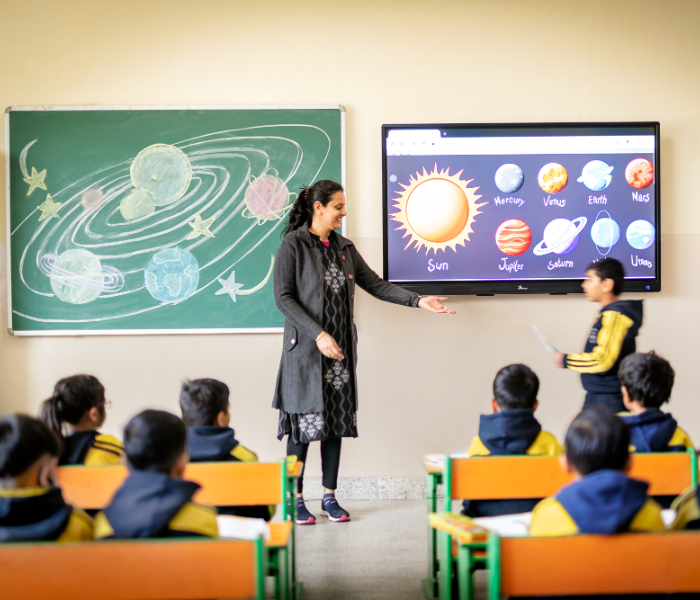Warning: Undefined array key "vp_page_image_desc" in /home/royalifems/public_html/edud/pages.php on line 37
Warning: Undefined array key "vp_section1_image_desc" in /home/royalifems/public_html/edud/pages.php on line 43
Warning: Undefined array key "vp_section2_image_desc" in /home/royalifems/public_html/edud/pages.php on line 49
Digital Classes
- Home
- >
- Digital Classes
Digital classes have revolutionized the way education is delivered, transforming traditional classrooms into dynamic, interactive learning environments. Here’s an exploration of what digital classes in schools entail:
1. Introduction to Digital Classes
- What Are Digital Classes?: Digital classes, also known as online or virtual classes, integrate technology into the learning process, using tools like computers, tablets, and smartboards to deliver lessons. They can take place in a physical classroom or entirely online.
- Evolution of Education: The rise of digital classes marks a significant shift from traditional teaching methods, making education more accessible, flexible, and personalized.
2. Key Features of Digital Classes
- Interactive Learning Tools: Digital classes utilize interactive whiteboards, educational software, and online platforms that allow students to engage with content in real-time. Tools like quizzes, polls, and discussion forums foster active participation.
- Multimedia Content: Lessons are enhanced with videos, animations, simulations, and virtual labs, making complex concepts easier to understand and retain.
- Access to Global Resources: Students can access a wealth of information from around the world, including online libraries, educational websites, and video lectures from experts in various fields.
3. Benefits of Digital Classes
- Personalized Learning: Digital platforms allow for personalized learning experiences, where students can learn at their own pace. Adaptive learning technologies adjust the difficulty of tasks based on individual performance.
- Enhanced Engagement: Interactive and multimedia content tends to keep students more engaged and motivated. Gamified learning experiences make education fun and immersive.
- Convenience and Flexibility: Digital classes offer the flexibility to learn anytime and anywhere. This is particularly beneficial for students who may have other commitments or those in remote areas.
- Real-Time Feedback: Teachers can provide instant feedback on assignments and assessments, helping students understand their mistakes and improve quickly.
4. Challenges and Solutions
- Digital Divide: Not all students have equal access to the necessary technology or the internet. Schools can address this by providing devices, offering offline resources, or creating community learning hubs.
- Teacher Training: Educators need to be proficient in using digital tools and platforms. Regular training and professional development programs are essential to equip teachers with the necessary skills.
- Screen Time Concerns: Prolonged exposure to screens can lead to health issues like eye strain. Schools can mitigate this by balancing screen-based activities with hands-on projects and encouraging regular breaks.
5. The Role of Teachers in Digital Classes
- Facilitators of Learning: In digital classes, teachers transition from traditional lecturers to facilitators who guide students through interactive and self-directed learning experiences.
- Monitoring Progress: Teachers can use digital platforms to track student progress, identify areas of improvement, and provide additional support where needed.
- Creating Collaborative Opportunities: Teachers can foster collaboration through group projects, peer reviews, and online discussion boards, encouraging students to learn from each other.
6. Future of Digital Classes
- Integration of AI and Machine Learning: Artificial intelligence can further personalize learning by analyzing student data and predicting learning patterns, providing customized educational experiences.
- Virtual and Augmented Reality: The use of VR and AR in digital classes can create immersive learning environments, allowing students to explore historical events, conduct virtual science experiments, or tour famous landmarks.
- Global Classrooms: Digital platforms enable cross-border collaboration, where students from different countries can work on projects together, broadening their perspectives and understanding of global issues.
7. Parental Involvement in Digital Classes
- Active Participation: Parents can play a more active role in their child’s education by monitoring their progress through digital platforms and communicating regularly with teachers.
- Support at Home: Providing a conducive learning environment at home, such as a quiet space and necessary technology, is crucial for the success of digital classes.



